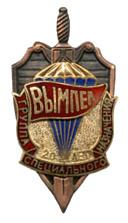Active 1981–present Size ≈ 1000 operators | Type Special forces Part of FSB (1991–present) | |
 | ||
Country Soviet Union (1981–1991)
Russian Federation (1991–) Role Counter-terrorism
Special operations | ||
Spetsgruppa "B" (Cyrillic for V), often referred to as Vympel (pennant in Russian, originated from Dutch wimpel, and having the same meaning), but also known as KGB Directorate "B" , Vega Group is a Russian spetsnaz unit, mostly under the command of the FSB, but some teams under GRU.
Contents
Vympel is the sister unit of Spetsgruppa "A"(Alpha Group), a KGB/FSB unit, while some soldiers have stayed part of the GRU, specialized in counter-terrorism missions.
History
The exact lineage of Vympel is not known but the unit was formed in 1981 by the KGB Maj. Gen. Yuri Ivanovich Drozdov within the First Chief Directorate of the KGB, as a dedicated spetsnaz unit specialised in deep penetration, sabotage, universal direct and covert action, protection of Soviet embassies and espionage cell activation in case of war. Most of the Vympel operatives mastered two or three foreign languages since they were intended to act in foreign countries, deep behind enemy lines. Vympel was tasked with assassinating the top leadership of enemy states and destroying strategic infrastructure in the critical "special period," when the outbreak of war between the superpowers would have been unavoidable.
Vympel quickly gained the reputation of being among the best Soviet special forces units, surpassing its GRU and MVD counterparts. However, after the collapse of the USSR, Vympel was decimated by endless re-organisation and re-definition. It passed under the aegis of the Security Ministry before being receded to the GUO (the two institutions were short-lived offspring of the ex-KGB during the Boris Yeltsin era) and finally passed to the MVD (Interior Ministry). However, the militsiya had no use for such a unit. The bulk of the Vympel operatives could not stand the humiliation of being subordinated to the police, and duly resigned: of 278 officers, only 57 chose to remain within the MVD. The unit was renamed "Vega."
In 1995, the FSB RF Special Operations Center (TsSN FSB RF) was granted control over Vympel. The group regained its original name and was reintegrated into the Intelligence Service structures. The emphasis shifted from covert and clandestine sabotage operations to counter-terrorism and nuclear safety enforcement. Vympel operatives undergo special training related to improvised or special explosive devices, permitting them to use "terrorist-like" tactics to carry out their operations. Physical training includes close hand combat, parachute training, diving, underwater combat techniques, climbing, and alpine rope techniques. Regional groups of Vympel were deployed in cities with especially important nuclear facilities.
Vympel, abbreviation of the Directorate в (Russian cyrillic for V) of the TsSN FSB of the Russian Federation, is still a classified and secretive unit. It took part in Russia's Chechen campaigns and in storming of the Supreme Soviet building during the 1993 Russian constitutional crisis. Little is known about its current operations and activities, the exception being the capture of the Chechen militant leader Salman Raduyev in March 2000 and the assault on the school in Beslan in September 2004.
Training
Vympel training is the same as Alpha Group. All Vympel operatives are trained in tactical operations, parachuting, driving various vehicles, trained in methods of intelligence gathering, and other specialized skills.
